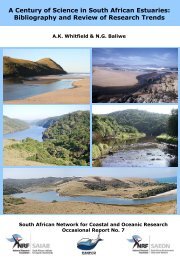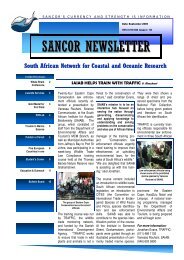SANCOR Newsletter -200 - Sancor home page - National Research ...
SANCOR Newsletter -200 - Sancor home page - National Research ...
SANCOR Newsletter -200 - Sancor home page - National Research ...
Create successful ePaper yourself
Turn your PDF publications into a flip-book with our unique Google optimized e-Paper software.
Page 9<strong>SANCOR</strong> NEWSLETTER #<strong>200</strong>The remote sensing unit of the CSIR CoastalSystems <strong>Research</strong> Group in Stellenboschexplored the use of space‐borne imagery forthe detecon and monitoring of coastal dynamics.The aim of the project was to provethat relevant land cover types and the posi‐on of their respecve borders can be extractedfrom satellite imagery in a pushbuonapproach. The push‐buon approachwas a requirement to ensure fast and efficientextracon of result for use in an opera‐onal coastal management environment.Such a system allows for the rapid, reliableand repeatable extracon of standardisedinformaon from a series of images overspace and me.Therefore it was decided to focus on theautomac detecon of beaches, coastalvegetaon, water (the ocean) and the surfzone. The posion of the waterline (as indicatorfor the shoreline) can then be extractedas the border between beach (or vegeta‐on) and ocean. When comparing imagesover me and taking into account dal varia‐on, changes in the posion of the waterline will reveal potenal erosion or accreonof the shore. The dal effect is of parcularimportance for shallow areas with greatinterdal ranges such as you would find inMozambique.We also extracted the surf zone, which is thenear‐shore area where the waves break. Forthe waves to break, the water needs a certainshallowness. Therefore, changes in thesurf zone can be taken as an indicator forchanges in the bathymetry which is the underwatershore topography. For example, adecreasing width of the surf zone might alertthe coastal manager of potenal erosionprocesses. Coastal stabilisaon measurescan then take place.We tested our approach on four coastallocaons which were Maputo Bay, Durban,Cape Agulhas and False Bay (Figure 1).Maputo Bay is characterised by a shallowsandy shore line which exposes large dalmudflats during low des. Using a Landsatimage which was taken at low de, the extensivemudflats could be detected (Figure30 Oct <strong>200</strong>1low de2 Sep <strong>200</strong>3high de23 Dec <strong>200</strong>9high deFigure 3: Another subset of the Landsat image for Maputo. Le: False colour image,same as in Figure 2. Right: the respecve classificaon results. The same colourcode as in Figure 2 is used. White arrow indicates changes in submerged sandbank.The black stripes in the <strong>200</strong>3 and <strong>200</strong>9 images originate from an error in the originalLandsat images.2). Comparing the dal states of a series ofimages helps to interpret the classificaonresults. For instance, we know that the Maputoimage from 30 Oct <strong>200</strong>1 (Figure 2 andFigure 3, top) was taken at low de. Extensiveinterdal mudflats are visible. In con‐trast, the images from 2 Sept <strong>200</strong>3 and 23Dec <strong>200</strong>9 (Figure 3, centre and boom) weretaken at high‐de. So their dal state is comparableand the images should look idencal.However, at the headland in the rightimage part (white arrow) there are differ‐







